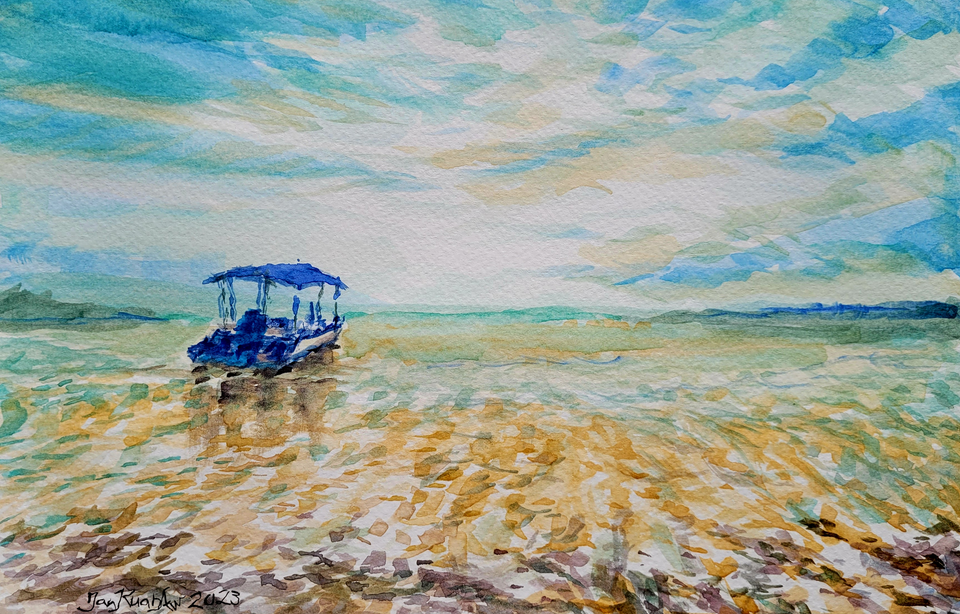Sailing away

Hello Debriefers,
This edition explores highlights from the most recent disability news.
We see problems with the globalisation of mental health and alternatives to be found in mad justice. Further highlights show different approaches to disability, online work in Kenya, stalled progress in assistive communications and more.
This is the last newsletter before a summer break: next month the Debrief will take a publishing pause. As well as some time off, I'll be working behind the scenes work to keep things shipshape. We're back in September.
One thing I'll be doing is making the library of disability news more user-friendly. If you have feedback or suggestions on how it could be better, let me know!
Disability Debrief is supported on a pay-as-you can basis. This edition has support from K. Li and new contributions from Say and Toby.
Globalising Mental Health
Years ago, working in Bangladesh, I saw a presentation in an embassy about how there were only hundreds of psychiatrists and psychologists in the country. According to the speaker that meant that a lot more professionals were needed. But it made me wonder what alternative approaches could be, given how big the gap was.
A recent article from Peter Beresford and Diana Rose on Decolonising Global Mental Health helps me understand the context of what I saw and the approaches it was recommending. The authors describe a “widespread and coordinated” move towards a global mental health:
“It has been understood to mean the rapid expansion of psychiatric interpretations and responses to human mental distress and difficulty. These have generally been framed in medicalised, individualistic terms, primarily seeing the problem or pathology in the individual, their family or, less often, the wider community.”
There has also been a growth over the past fifty years of movements led by survivors of psychiatry, often in stark opposition to the medicalised approaches of global mental health. Also international, these movements have often adopted wider social approaches, prioritised self-advocacy and self-organisation and used human-rights approaches – including those based on disability rights. As my conversation with Bhargavi Davar illustrated last year, this approach often rejects medical approaches to mental health as having colonial roots.
Beresford and Rose show how the global mental health movement reproduces colonial dynamics of imposing different structures and ignoring the people affected by them. As two Western professors they are less convincing when they talk about decolonisation and suggest that their own academic discipline of Mad Studies is a solution to the power struggle.
Mad Justice and Reparation
A more convincing look at resisting global mental health comes from Latin America, with Redesfera's report For Mad Justice and Reparation. Redesfera are a regional group led by people with psychosocial diversity themselves:
“The self-organization of people with psychosocial diversity has generated, for at least five decades, a broad social movement that has made it possible to destabilise diagnostic categories, resist psychopathologization, create knowledge, create countercultures, and promote mad culture. This mobilization has also made it possible to name the different forms of structural and systematic violence that affect us as a collective: sanism.”
The term “psychosocial diversity” is a broad label including multiple identities and experiences. It deliberately insists on a socially-oriented identity and avoids clinical terms from psychiatry. It is also different from “disability”. Much as our idea of disability is socially conceived, it assumes an underlying “impairment”. In this case that is precisely one of the points in question and Redesfera resist the pathologisation of their diversity.
Their report is particularly useful in showing the scope and nuance of actions required to achieve rights and inclusion. Exploring “psychosocial diversity” takes the report into areas of disability rights, mental health, and anti-discrimination. It shows where policy and institutions in these different areas support or contradict each other. At the same time disability rights legislation and policy does not do enough to protect the rights of people with psychosocial diversity, mental health policies continue to advance clinical categorisation and responses.
Resistance and action includes challenging violence and medicalisation within psychiatry-based approaches, but is not solely framed in terms of that opposition. And it is certainly not limited to one mode of action or knowledge. Alternatives are found not only in advocacy for policy and legislation, but mutual support, new economic relations, and interventions in media and arts.
“We need to have all the possible tools (grassroots activism, political and legal advocacy, knowledge production, etc.) to defend ourselves against institutional violence, prejudice, stigma, and any form of discrimination or pathologization that prevents us from making our own decisions and being an active part of our communities.”
The report is in Spanish, translation from me and google.
Approaches to disability, warts and all
Andrew Pulrang has been exploring the “main types of activity in modern disability culture”. He labels them as (1) activism of protests and advocacy (2) adaptation, finding practical ways to improve life, and (3) and awareness, with attitude change, information and education.
One of the reason he describes them is that each of these approaches has its “partisans” – people who insist that relating in that way to disability is better than the others. Contradictions are particularly visible when efforts organizations make on disability inclusion clash with individual experiences. For example, in employment:
‘In political environments where some disabled people are pressured to “get a job or else lose benefits,” tips for disabled people to do better in the workplace can compound that pressure, rather than relieve it. Some disabled people want very much to work, and really do crave advice on how to navigate the barriers they face in the workplace. But plenty of other disabled people understandably read “employment strategies” and lessons on “workplace skills” as thinly veiled mandates or threats.’
These tensions also play out for us as individuals, and during July – Disability Pride Month – many have been reflecting on how we reconcile activism and adaptation. Disability writer Charlie Park asks how she can be proud of her sick body and proposes an “acceptance model” of disability: “Acceptance (not always love) of my body as it is; warts and all because it's the only one that I have.”
In contrast, journalist Lucy Webster acknowledges the difficulties of disabled living, and it is precisely these that cause her to lean into disability pride, as a “radical rewriting of the world”:
“Pride is about having a deep sense of self-worth in the face of oppression. It is about staring ableism and inaccessibility in the eyes and knowing we deserve better. It is about acknowledging pain and fatigue and claiming our right to real rest. It is about renouncing narratives that say we do not belong and rejecting unbelievable pressure to conform.”
How can you prove it's good quality?
In Kenya, a report explores challenges disabled people face doing online work. As digital commerce grows everywhere, the disabled people featured were selling clothing, food and goods, as well as providing freelance services or consultancy. For most of the respondents the income was small, but one in three of them felt their online work was successful.
Even as digital work opens up new possibilities, familiar barriers are there. Disabled people have extra costs, and continue to face inaccessibility and discrimination. Customers might insist on a phone call even if the seller is deaf. One young woman with a visual impairment, said that customers “don’t trust [that] people with disability can deliver quality products. Someone will ask ‘You don’t see the cloth, how can you prove it is of good quality?’”
Depressingly little innovation
Speaking of the promises of digital technology, Julie Kim explored “depressingly little innovation” in Augmentative and Alternative Communication (AAC) technology:
“The reality is this: the last major advance in AAC technology happened 13 years ago, an eternity in technology time. On April 3, 2010, Steve Jobs debuted the iPad. What for most people was basically a more convenient form factor was something far more consequential for non-speakers: a life-changing revolution in access to an attractive, portable, and powerful communication device for just a few hundred dollars. [...] For the first time, AAC users could use the same device they used for speaking to do other things, like text, FaceTime, browse the web, watch movies, record audio, and share photos.”
Even as some text-to-speech software keeps getting better, “the options dwindle for pre-literate and cognitively impaired users who communicate with picture-based vocabularies.” Kim's essay explores how some of the barriers to innovation are to be found in the very companies that provide the technology. Incentives point towards creating more expensive but less useful products:
“In order to comply with Medicaid and health insurance requirements, third-party AAC technology providers usually strip Apple’s native applications off the iPads they distribute—making them less useful, at 10 or 20 times the price, than the same piece of hardware that I (or anyone else) can buy off the shelf.”
“That's where all the braille is”
My favourite quotes from the past month or two...
“I hate the word inclusion” Argentinian activist Julia Risso prefers the word “socialise”:
“So who decides who includes? The one that's always inside, and that's always the same. Normality is not discussed, the fact that there is a standard and that everything else is outside. I'm already here, I don't want to be included anywhere. I want everything to change” (translation)
“It's hard to get through a month without a mental health awareness campaign rearing its well-meaning head.” Societies are opening up about mental health, but Eleanor de Jong asks who this includes:
“The sickest people I’ve ever known – myself included – have had almost no part in this opening up, as if we’re suffering from a different condition altogether.”
“What kind of jobs can persons with disabilities do?” One of the most frequent questions you hear working on inclusion in employment. Meg O'Connell found a succinct answer: “Literally, every job. Whatever job you can think of, there is a person with a disability doing it. Including your job.”
“The art of transformation”: Chancey Fleet on tactile graphic design making rich imagery accessible to blind and low vision people: “what appeals to the eye may be cluttered and chaotic to the fingertips.”
Living in elevators. A recent Vocal Fries podcast highlights a revealing exchange from Georgina Kleege's article “Visible Braille/Invisible Blindness”:
“‘Why do all the blind people live in elevators?’, the little girl asks.
Perplexed, the woman leans down and says, ‘What makes you think that blind people live in elevators?’
‘Because that’s where all the braille is.’”
Before we go...
Before we go, a correction. Last week's edition about care described Vikki as coming from India and working in the UK. In fact, Vikki is part of the Revival network but originally from the UK.
If you can't go a month without the Debrief... Catch-up on some of our recent features:
- Considered a backup: Anna Maria explores the overlooked power of disabled care
- How many disabled people are there? Jennifer Madans tells us why the complexity of disability can't be reduced to one number.
- My prayer to failure: I reflect on work that shaped my career.
Beyond those, you can also explore the library of disability news – and please do let me know your feedback on how I can continue to improve it.
See you in September,
Peter
Acknowledgements
Thanks to the illustration by Tan Kuan Aw. It is based on a photo by Chan Seng Hoe.
Thanks to Alberto Vasquez for helping me understand context on some of the above pieces.
Disability Debrief is supported by the individuals and organisations that read it. This edition has support from K. Li.
